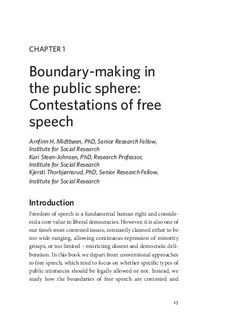Boundary-making in the public sphere: Contestations of free speech
Chapter
Published version
Permanent lenke
http://hdl.handle.net/11250/2450137Utgivelsesdato
2017Metadata
Vis full innførselSamlinger
- Del av bok/rapport [43]
- Publikasjoner fra CRIStin [715]
Sammendrag
Freedom of speech is a fundamental human right and considered a core value in liberal democracies. However, it is also one of our time’s most contested issues, constantly claimed either to be too wide-ranging, allowing continuous repression of minority groups, or too limited – restricting dissent and democratic deliberation. In this book we depart from conventional approaches of free speech, which tend to focus on whether specific types of public talk should be considered legally allowed or not. Instead, we study how boundaries of free speech are contested and negotiated through social processes which silence certain groups and opinions while amplifying others. Theoretically, we build on the concepts of boundaries and boundary-work. The study of symbolic and social boundaries has a long tradition in sociological and anthropological research, but is less used in current scholarship on free speech. We believe that this field of research can benefit from employing this perspective because it allows us to study the social processes through which boundaries of free speech are drawn, maintained and changed. How are boundaries of free speech defined – explicitly or implicitly – by institutional elites? And how are these boundaries perceived by the mainstream public and from the margins of the public sphere? These questions direct our attention to fundamental dynamics of the public sphere: Public debates are shaped by social mechanisms which silence certain groups and opinions, while amplifying the voice of others. These mechanisms create boundaries that are not (primarily) defined through judicial paragraphs, but rather barriers made of different types of perceived pressure, self-censorship, exclusion and stigma. Sometimes boundaries of free speech appear bright and clear-cut, based on a strong consensus regarding what opinions and groups are considered legitimate or illegitimate in the public sphere. However, they are more often blurred and ambiguous, leaving room both for explicit conflict over where the boundaries are or should be drawn, and for individual maneuvering in the public sphere based on assumptions about the subtle rules defining ‘the game’ of public participation. In a sociological perspective, we argue, the public sphere can be seen as a locus of ‘boundary struggles’: Constant debates over the boundaries of free speech shape the dynamics of public debates and gradually change what actors and opinions are granted a legitimate space in the public sphere.
